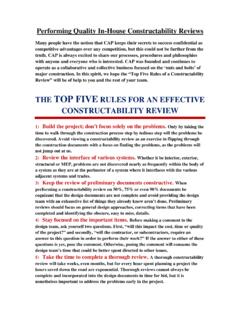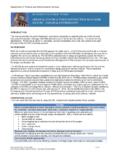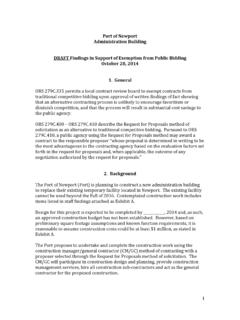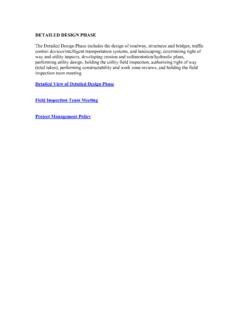Transcription of CONSTRUCTION PROJECT DELIVERY SYSTEMS …
1 CONSTRUCTION PROJECT DELIVERY SYSTEMS . AND PROCUREMENT PRACTICES: CONSIDERATIONS. ALTERNATIVES. ADVANTAGES. DISADVANTAGES. Prepared By: Trauner Consulting Services, Inc. APRIL 2007. Copyright 2007 by Trauner Consulting Services, Inc. No part of this publication may be reproduced, stored in a retrieval system , or transmitted in any form or by any means without the prior written permission of Trauner Consulting Services, Inc. PROJECT DELIVERY SYSTEMS . PROJECT DELIVERY SYSTEMS refer to the overall processes by which a PROJECT is designed, constructed, and/or maintained. In the public sector, this has traditionally entailed the almost exclusive use of the design-bid- build system , involving the separation of design and CONSTRUCTION services and sequential performance of design and CONSTRUCTION .
2 In recent years, however, the public sector has begun experimenting with alternative methods to improve the speed and efficiency of the PROJECT DELIVERY process. These alternative SYSTEMS move closer to the integrated services approach to PROJECT DELIVERY favored in the private sector. To illustrate this concept, the innovative DELIVERY SYSTEMS have been arranged below on a continuum, with the traditional design-bid-build approach appearing on the left and the more innovative SYSTEMS arranged from left to right according to increasing similarity to the private sector model in terms of greater responsibility and risk shifted to the constructor, and less separation between design and CONSTRUCTION services. DELIVERY SYSTEMS Agency-CM Design- Alliancing Sequencing ECI.
3 Design- Portland Method Public-Private CM at-Risk Design- Bid-Build Partnership ID/IQ Build Private Sector Model: Public Sector Model: Single entity provides integrated Separation of services for services design and CONSTRUCTION Design Fixed-price, low bid (for Construct CONSTRUCTION ). Operate Owner retains majority of risk for Maintain performance Finance Negotiated or target pricing Long-term partnerships Contractor assumes greater performance risk 1. PROJECT DELIVERY SYSTEMS Design-Bid-Build Description Design-Bid-Build (DBB), or design then bid then build, is the traditional DELIVERY system for the public sector, in which an agency will use in-house staff (or, alternatively, use consultants) to prepare fully completed plans and specifications that are then incorporated into a bid package.
4 Contractors competitively bid the PROJECT based on these completed plans and specifications. The agency evaluates the bids received, awards the contract to the lowest responsible and responsive bidder, uses prescriptive or method specifications for CONSTRUCTION , and retains significant responsibility for quality, cost, and time performance. Advantages Disadvantages Applicable to a wide range of projects Tends to yield base level quality Well established and easily understood Least-cost approach requires higher level of inspection by the agency Clearly defined roles for all parties Initial low bid might not result in Provides the lowest initial price that ultimate lowest cost or final best value responsible, competitive bidders can offer Designers may have limited knowledge of the true cost and Extensive litigation has resulted in scheduling ramifications of design well established legal precedents decisions No legal barriers in procurement and Lack of input from the CONSTRUCTION licensing industry during the design stage Insurance and bonding are well exposes the agency to claims related to defined design and constructability issues Discourages favoritism in spending Tends to create an adversarial public funds while stimulating relationship among the contracting competition in the private sector parties.
5 Rather than foster a cooperative atmosphere in which issues can be As CONSTRUCTION features are typically resolved efficiently and effectively fully specified, DBB provides agencies with significant control over the end Agency bears design adequacy risk product (however, this may come at No built-in incentives for contractors the expense of increased agency- to provide enhanced performance inspection efforts). (cost, time, quality, or combination thereof). Greatest potential for cost/time growth (in comparison to other DELIVERY methods). Often prone to adversarial positions that lead to disputes and claims 2 Design-Bid-Build PROJECT DELIVERY SYSTEMS Indefinite DELIVERY /Indefinite Quantity (ID/IQ). Description With ID/IQ contracting (also referred to as job order, task order, area-wide, county-wide, city-wide, and open-ended contracting), the agency will identify and develop specifications for task items.
6 Contractors then competitively bid these task items based on unit prices for task items for a specific contract term. The total quantity and exact location of the work are not provided at the time of bid. After awarding the contract, the agency will issue individual work orders as services are needed at specific locations. The uncertainty associated with the scheduling of the work and the quantity of work that will ultimately be let has led some agencies to guarantee a minimum value of work to ID/IQ contractors. Objective Time savings in engineering and procurement PROJECT Types/Selection Criteria Clearly defined, standardized, or repetitive work items Minor CONSTRUCTION , maintenance, pavement marking, signing, and repair contracts that can be classified into small task orders Advantages Disadvantages Reduces overall procurement time by Large packages could exclude smaller allowing agencies to eliminate contractors from bidding separate bid processes for repetitive Without minimum work guarantees.
7 Work items the possibility that selection for award Structuring work in small tasks may may not necessarily lead to work offer increased opportunities for orders may discourage potential smaller or disadvantaged businesses bidders Provides flexibility in when to let Without advance knowledge of the portions of an overall CONSTRUCTION timing and duration of task orders, it is program more difficult for ID/IQ contractors to manage resources Awarding multiple ID/IQ contracts will ensure competitive pricing of work orders Long-term contracts can foster a spirit of cooperation/partnership between contractors and the agency 3 ID/IQ. PROJECT DELIVERY SYSTEMS Agency- CONSTRUCTION Manager (Agency-CM). Description Agency-CM (also known as Program Management for multiple contracts or programs) is a fee-based service in which the CONSTRUCTION manager (CM) is exclusively responsible to the agency and acts as the agency's representative at every stage of the PROJECT .
8 The CM is selected based on qualifications and experience, similar to the selection process for design services. CM responsibilities may include providing advice during the design phase, evaluating bids from prime contractors, overseeing CONSTRUCTION , and managing PROJECT cost, schedule, and quality. The CM may work with the designer or contractor to reduce the cost, but does not guarantee price or take on the contractual responsibility for design and CONSTRUCTION . Objective Supplement in-house staff with independent professionals having expertise in PROJECT management, scheduling, and cost control Time savings by fast-tracking CONSTRUCTION PROJECT Types/Selection Criteria Agency must supplement its internal resources and management expertise given the PROJECT 's size or complexity Large, complex (multi-season) projects with multiple phases or contracts Fast-tracked CONSTRUCTION (using phased packages) is possible 4 Agency-CM.
9 PROJECT DELIVERY SYSTEMS Advantages Disadvantages Earlier involvement of CM Added PROJECT management cost for (constructor) bridges design and CM services CONSTRUCTION phases Agency cedes much of the day-to-day Furnishes CONSTRUCTION expertise to control over the PROJECT to the CM, designer adding a level of bureaucracy in the field Provides the opportunity for fast- tracking or overlapping design and CM not at risk for CONSTRUCTION cost CONSTRUCTION phases faster than Agency continues to hold CONSTRUCTION traditional design-bid-build system contracts and retains contractual Augments the agency's own resources liability to help manage cost, time, and quality Unlike CM at-Risk, Agency-CM. Procuring separate design and services are not regulated by state CONSTRUCTION contracts is less change licensing laws for contractors or A/E.
10 For agency firms Provides an independent point of view High agency involvement (in regarding constructability, budget, comparison to other innovative value engineering, and contractor DELIVERY SYSTEMS ). selection (No inherent bias towards design or CONSTRUCTION ). Potential to fast-track early components of CONSTRUCTION prior to completion of design Reduces the agency's general management and oversight responsibilities 5 Agency-CM. PROJECT DELIVERY SYSTEMS CONSTRUCTION Manager at Risk (CM at-Risk). Description With CM at Risk, the agency engages a CONSTRUCTION manager (CM) to act as the agency's consultant during the pre- CONSTRUCTION phase and as the general contractor (GC) during CONSTRUCTION . During the design phase, the CM acts in an advisory role, providing constructability reviews, value engineering suggestions, CONSTRUCTION estimates, and other CONSTRUCTION -related recommendations.
![Welcome [www.fefpa.org]](/cache/preview/0/a/5/c/1/8/d/8/thumb-0a5c18d86c60b70ba93ed11342457031.jpg)







